snow chains Seat Ateca 2016 Owner's Manual
[x] Cancel search | Manufacturer: SEAT, Model Year: 2016, Model line: Ateca, Model: Seat Ateca 2016Pages: 328, PDF Size: 6.32 MB
Page 5 of 328
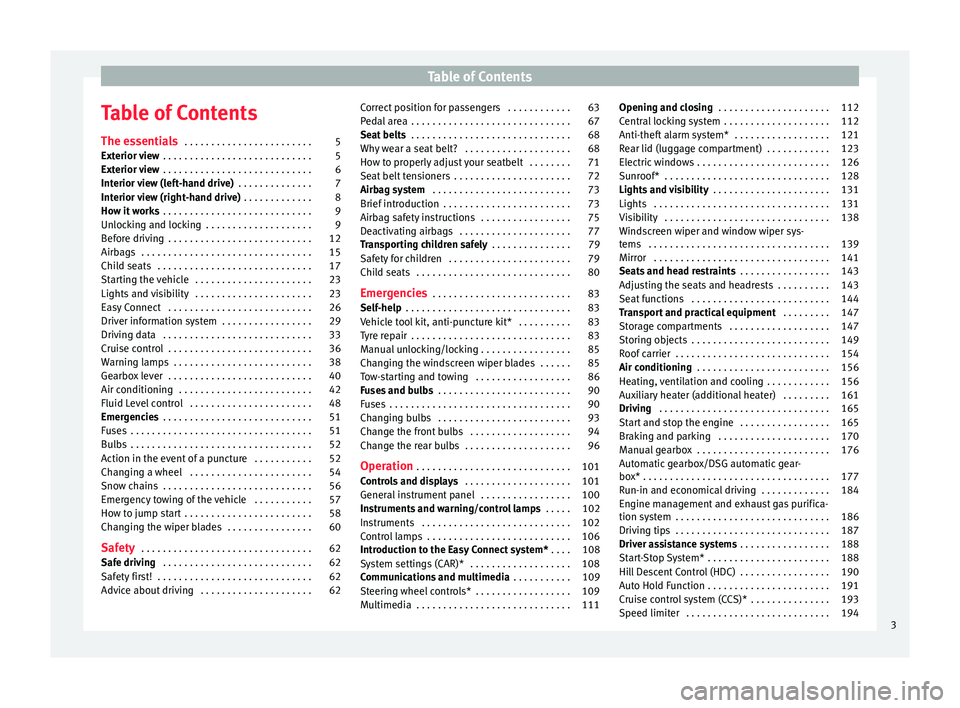
Table of Contents
Table of Contents
The e s
sentials . . . . . . . . . . . . . . . . . . . . . . . . 5
Exterior view . . . . . . . . . . . . . . . . . . . . . . . . . . . . 5
Exterior view . . . . . . . . . . . . . . . . . . . . . . . . . . . . 6
Interior view (left-hand drive) . . . . . . . . . . . . . . 7
Interior view (right-hand drive) . . . . . . . . . . . . . 8
How it works . . . . . . . . . . . . . . . . . . . . . . . . . . . . 9
Unlocking and locking . . . . . . . . . . . . . . . . . . . . 9
Before driving . . . . . . . . . . . . . . . . . . . . . . . . . . . 12
Airbags . . . . . . . . . . . . . . . . . . . . . . . . . . . . . . . . 15
Child seats . . . . . . . . . . . . . . . . . . . . . . . . . . . . . 17
Starting the vehicle . . . . . . . . . . . . . . . . . . . . . . 23
Lights and visibility . . . . . . . . . . . . . . . . . . . . . . 23
Easy Connect . . . . . . . . . . . . . . . . . . . . . . . . . . . 26
Driver information system . . . . . . . . . . . . . . . . . 29
Driving data . . . . . . . . . . . . . . . . . . . . . . . . . . . . 33
Cruise control . . . . . . . . . . . . . . . . . . . . . . . . . . . 36
Warning lamps . . . . . . . . . . . . . . . . . . . . . . . . . . 38
Gearbox lever . . . . . . . . . . . . . . . . . . . . . . . . . . . 40
Air conditioning . . . . . . . . . . . . . . . . . . . . . . . . . 42
Fluid Level control . . . . . . . . . . . . . . . . . . . . . . . 48
Emergencies . . . . . . . . . . . . . . . . . . . . . . . . . . . . 51
Fuses . . . . . . . . . . . . . . . . . . . . . . . . . . . . . . . . . . 51
Bulbs . . . . . . . . . . . . . . . . . . . . . . . . . . . . . . . . . . 52
Action in the event of a puncture . . . . . . . . . . . 52
Changing a wheel . . . . . . . . . . . . . . . . . . . . . . . 54
Snow chains . . . . . . . . . . . . . . . . . . . . . . . . . . . . 56
Emergency towing of the vehicle . . . . . . . . . . . 57
How to jump start . . . . . . . . . . . . . . . . . . . . . . . . 58
Changing the wiper blades . . . . . . . . . . . . . . . . 60
Safety . . . . . . . . . . . . . . . . . . . . . . . . . . . . . . . . 62
Safe driving . . . . . . . . . . . . . . . . . . . . . . . . . . . . 62
Safety first! . . . . . . . . . . . . . . . . . . . . . . . . . . . . . 62
Advice about driving . . . . . . . . . . . . . . . . . . . . . 62 Correct position for passengers . . . . . . . . . . . . 63
Pedal area . . . . . . . . . . . . . . . . . . . . . . . . . . . . . . 67
Seat belts
. . . . . . . . . . . . . . . . . . . . . . . . . . . . . . 68
Why wear a seat belt? . . . . . . . . . . . . . . . . . . . . 68
How to properly adjust your seatbelt . . . . . . . . 71
Seat belt tensioners . . . . . . . . . . . . . . . . . . . . . . 72
Airbag system . . . . . . . . . . . . . . . . . . . . . . . . . . 73
Brief introduction . . . . . . . . . . . . . . . . . . . . . . . . 73
Airbag safety instructions . . . . . . . . . . . . . . . . . 75
Deactivating airbags . . . . . . . . . . . . . . . . . . . . . 77
Transporting children safely . . . . . . . . . . . . . . . 79
Safety for children . . . . . . . . . . . . . . . . . . . . . . . 79
Child seats . . . . . . . . . . . . . . . . . . . . . . . . . . . . . 80
Emergencies . . . . . . . . . . . . . . . . . . . . . . . . . . 83
Self-help . . . . . . . . . . . . . . . . . . . . . . . . . . . . . . . 83
Vehicle tool kit, anti-puncture kit* . . . . . . . . . . 83
Tyre repair . . . . . . . . . . . . . . . . . . . . . . . . . . . . . . 83
Manual unlocking/locking . . . . . . . . . . . . . . . . . 85
Changing the windscreen wiper blades . . . . . . 85
Tow-starting and towing . . . . . . . . . . . . . . . . . . 86
Fuses and bulbs . . . . . . . . . . . . . . . . . . . . . . . . . 90
Fuses . . . . . . . . . . . . . . . . . . . . . . . . . . . . . . . . . . 90
Changing bulbs . . . . . . . . . . . . . . . . . . . . . . . . . 93
Change the front bulbs . . . . . . . . . . . . . . . . . . . 94
Change the rear bulbs . . . . . . . . . . . . . . . . . . . . 96
Operation . . . . . . . . . . . . . . . . . . . . . . . . . . . . . 101
Controls and displays . . . . . . . . . . . . . . . . . . . . 101
General instrument panel . . . . . . . . . . . . . . . . . 100
Instruments and warning/control lamps . . . . . 102
Instruments . . . . . . . . . . . . . . . . . . . . . . . . . . . . 102
Control lamps . . . . . . . . . . . . . . . . . . . . . . . . . . . 106
Introduction to the Easy Connect system* . . . . 108
System settings (CAR)* . . . . . . . . . . . . . . . . . . . 108
Communications and multimedia . . . . . . . . . . . 109
Steering wheel controls* . . . . . . . . . . . . . . . . . . 109
Multimedia . . . . . . . . . . . . . . . . . . . . . . . . . . . . . 111 Opening and closing
. . . . . . . . . . . . . . . . . . . . . 112
Central locking system . . . . . . . . . . . . . . . . . . . . 112
Anti-theft alarm system* . . . . . . . . . . . . . . . . . . 121
Rear lid (luggage compartment) . . . . . . . . . . . . 123
Electric windows . . . . . . . . . . . . . . . . . . . . . . . . . 126
Sunroof* . . . . . . . . . . . . . . . . . . . . . . . . . . . . . . . 128
Lights and visibility . . . . . . . . . . . . . . . . . . . . . . 131
Lights . . . . . . . . . . . . . . . . . . . . . . . . . . . . . . . . . 131
Visibility . . . . . . . . . . . . . . . . . . . . . . . . . . . . . . . 138
Windscreen wiper and window wiper sys-
tems
. . . . . . . . . . . . . . . . . . . . . . . . . . . . . . . . . . 139
Mirror . . . . . . . . . . . . . . . . . . . . . . . . . . . . . . . . . 141
Seats and head restraints . . . . . . . . . . . . . . . . . 143
Adjusting the seats and headrests . . . . . . . . . . 143
Seat functions . . . . . . . . . . . . . . . . . . . . . . . . . . 144
Transport and practical equipment . . . . . . . . . 147
Storage compartments . . . . . . . . . . . . . . . . . . . 147
Storing objects . . . . . . . . . . . . . . . . . . . . . . . . . . 149
Roof carrier . . . . . . . . . . . . . . . . . . . . . . . . . . . . . 154
Air conditioning . . . . . . . . . . . . . . . . . . . . . . . . . 156
Heating, ventilation and cooling . . . . . . . . . . . . 156
Auxiliary heater (additional heater) . . . . . . . . . 161
Driving . . . . . . . . . . . . . . . . . . . . . . . . . . . . . . . . 165
Start and stop the engine . . . . . . . . . . . . . . . . . 165
Braking and parking . . . . . . . . . . . . . . . . . . . . . 170
Manual gearbox . . . . . . . . . . . . . . . . . . . . . . . . . 176
Automatic gearbox/DSG automatic gear-
box*
. . . . . . . . . . . . . . . . . . . . . . . . . . . . . . . . . . . 177
Run-in and economical driving . . . . . . . . . . . . . 184
Engine management and exhaust gas purifica-
tion sys
tem . . . . . . . . . . . . . . . . . . . . . . . . . . . . . 186
Driving tips . . . . . . . . . . . . . . . . . . . . . . . . . . . . . 187
Driver assistance systems . . . . . . . . . . . . . . . . . 188
Start-Stop System* . . . . . . . . . . . . . . . . . . . . . . . 188
Hill Descent Control (HDC) . . . . . . . . . . . . . . . . . 190
Auto Hold Function . . . . . . . . . . . . . . . . . . . . . . . 191
Cruise control system (CCS)* . . . . . . . . . . . . . . . 193
Speed limiter . . . . . . . . . . . . . . . . . . . . . . . . . . . 194 3
Page 58 of 328
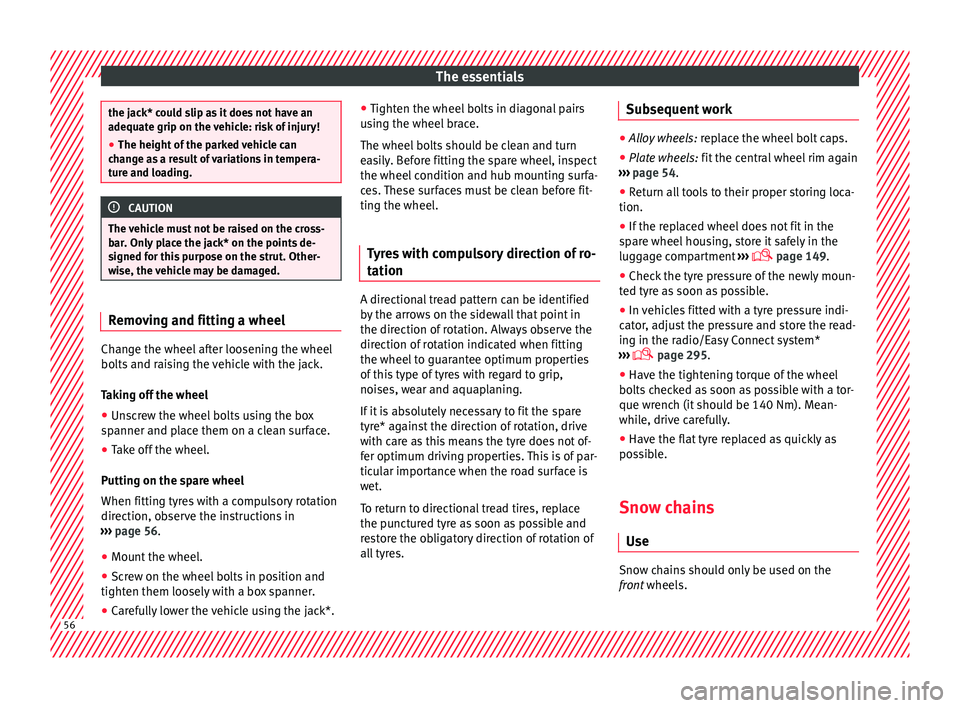
The essentials
the jack* could slip as it does not have an
a
dequat
e grip on the vehicle: risk of injury!
● The height of the parked vehicle can
ch
ange as a result of variations in tempera-
ture and loading. CAUTION
The vehicle must not be raised on the cross-
b ar
. Only place the jack* on the points de-
signed for this purpose on the strut. Other-
wise, the vehicle may be damaged. Removing and fitting a wheel
Change the wheel after loosening the wheel
bo
lts
and raising the vehicle with the jack.
Taking off the wheel ● Unscrew the wheel bolts using the box
sp
anner and place them on a clean surface.
● Take off the wheel.
Puttin
g on the spare wheel
When fitting tyres with a compulsory rotation
direction, observe the instructions in
››› page 56.
● Mount the wheel.
● Screw on the wheel bolts in position and
tight en them loo
sely with a box spanner.
● Carefully lower the vehicle using the jack*. ●
Tight en the wheel
bolts in diagonal pairs
using the wheel brace.
The wheel bolts should be clean and turn
easily. Before fitting the spare wheel, inspect
the wheel condition and hub mounting surfa-
ces. These surfaces must be clean before fit-
ting the wheel.
Tyres with compulsory direction of ro-
tation A directional tread pattern can be identified
b
y
the arrows on the sidewall that point in
the direction of rotation. Always observe the
direction of rotation indicated when fitting
the wheel to guarantee optimum properties
of this type of tyres with regard to grip,
noises, wear and aquaplaning.
If it is absolutely necessary to fit the spare
tyre* against the direction of rotation, drive
with care as this means the tyre does not of-
fer optimum driving properties. This is of par-
ticular importance when the road surface is
wet.
To return to directional tread tires, replace
the punctured tyre as soon as possible and
restore the obligatory direction of rotation of
all tyres. Subsequent work ●
Alloy wheels: rep
lace the wheel bolt caps.
● Plate wheels: fit the c
entral wheel rim again
››› page 54.
● Return all tools to their proper storing loca-
tion.
● If the replaced wheel does not fit in the
sp
are wheel housing, store it safely in the
luggage compartment ›››
page 149.
● Check the tyre pressure of the newly moun-
ted ty
re as soon as possible.
● In vehicles fitted with a tyre pressure indi-
c at
or, adjust the pressure and store the read-
ing in the radio/Easy Connect system*
››› page 295.
● Have the tightening torque of the wheel
bolts
checked as soon as possible with a tor-
que wrench (it should be 140 Nm). Mean-
while, drive carefully.
● Have the flat tyre replaced as quickly as
pos
sible.
Snow chains Use Snow chains should only be used on the
fr
on
t wheels.56
Page 59 of 328
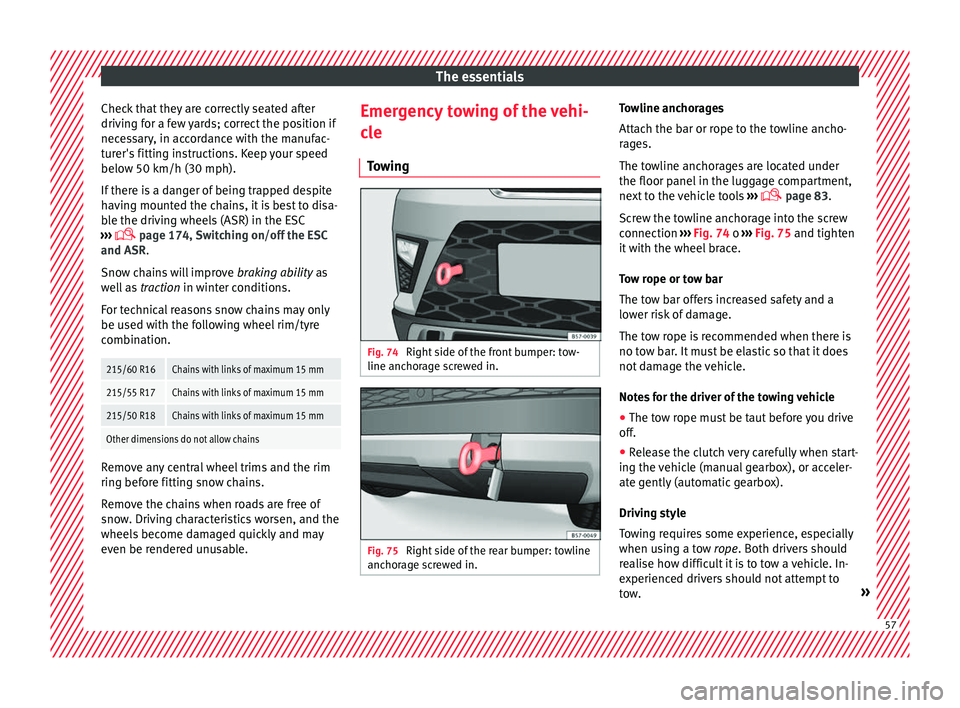
The essentials
Check that they are correctly seated after
driv in
g for a few yards; correct the position if
necessary, in accordance with the manufac-
turer's fitting instructions. Keep your speed
below 50 km/h (30 mph).
If there is a danger of being trapped despite
having mounted the chains, it is best to disa-
ble the driving wheels (ASR) in the ESC
››› page 174, Switching on/off the ESC
and ASR.
Snow chains will improve braking ability as
well as traction in winter conditions.
For technical reasons snow chains may only
be used with the following wheel rim/tyre
combination.
215/60 R16Chains with links of maximum 15 mm
215/55 R17Chains with links of maximum 15 mm
215/50 R18Chains with links of maximum 15 mm
Other dimensions do not allow chains Remove any central wheel trims and the rim
rin
g bef
ore fitting snow chains.
Remove the chains when roads are free of
snow. Driving characteristics worsen, and the
wheels become damaged quickly and may
even be rendered unusable. Emergency towing of the vehi-
cl
e
Towing Fig. 74
Right side of the front bumper: tow-
line anc hor
age screwed in. Fig. 75
Right side of the rear bumper: towline
anc hor
age screwed in. Towline anchorages
Att
ac
h the bar or rope to the towline ancho-
rages.
The towline anchorages are located under
the floor panel in the luggage compartment,
next to the vehicle tools ›››
page 83.
Screw the towline anchorage into the screw
connection ››› Fig. 74 o ››› Fig. 75 and tighten
it with the wheel brace.
Tow rope or tow bar
The tow bar offers increased safety and a
lower risk of damage.
The tow rope is recommended when there is
no tow bar. It must be elastic so that it does
not damage the vehicle.
Notes for the driver of the towing vehicle
● The tow rope must be taut before you drive
off.
● R
elease the clutch very carefully when start-
ing the
vehicle (manual gearbox), or acceler-
ate gently (automatic gearbox).
Driving style
Towing requires some experience, especially
when using a tow rope. Both drivers should
realise how difficult it is to tow a vehicle. In-
experienced drivers should not attempt to
tow. » 57
Page 242 of 328
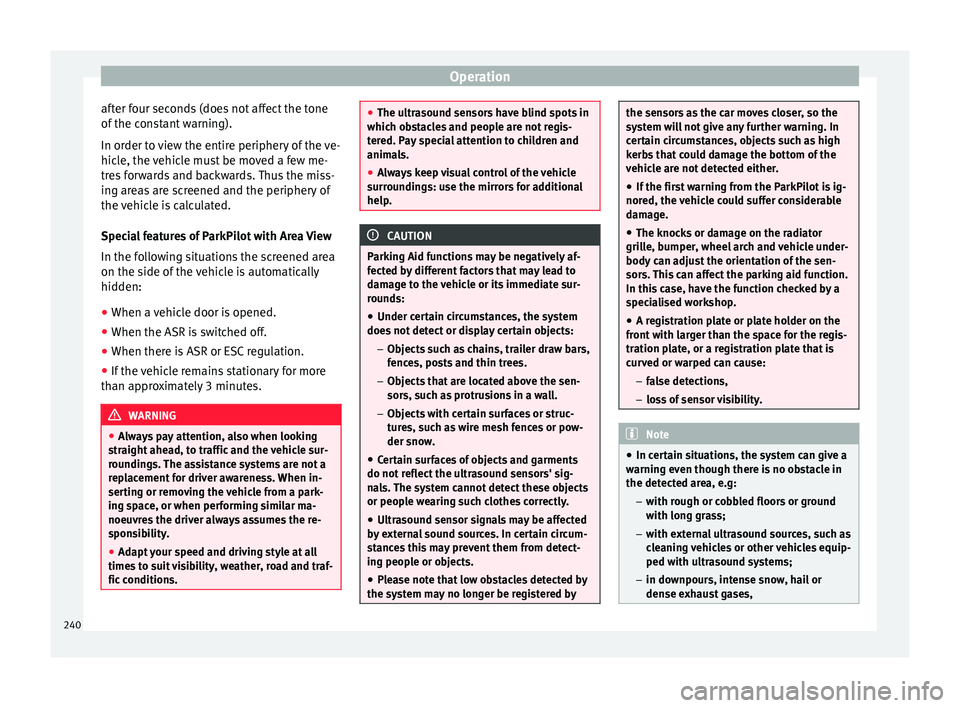
Operation
after four seconds (does not affect the tone
of the c
onstant warning).
In order to view the entire periphery of the ve-
hicle, the vehicle must be moved a few me-
tres forwards and backwards. Thus the miss-
ing areas are screened and the periphery of
the vehicle is calculated.
Special features of ParkPilot with Area View
In the following situations the screened area
on the side of the vehicle is automatically
hidden:
● When a vehicle door is opened.
● When the ASR is switched off.
● When there is ASR or ESC regulation.
● If the vehicle remains stationary for more
than ap
proximately 3 minutes. WARNING
● Alw
ays pay attention, also when looking
straight ahead, to traffic and the vehicle sur-
roundings. The assistance systems are not a
replacement for driver awareness. When in-
serting or removing the vehicle from a park-
ing space, or when performing similar ma-
noeuvres the driver always assumes the re-
sponsibility.
● Adapt your speed and driving style at all
times
to suit visibility, weather, road and traf-
fic conditions. ●
The u ltr
asound sensors have blind spots in
which obstacles and people are not regis-
tered. Pay special attention to children and
animals.
● Always keep visual control of the vehicle
surr
oundings: use the mirrors for additional
help. CAUTION
Parking Aid functions may be negatively af-
f ect
ed by different factors that may lead to
damage to the vehicle or its immediate sur-
rounds:
● Under certain circumstances, the system
does
not detect or display certain objects:
– Objects such as chains, trailer draw bars,
fences, posts and thin trees.
– Objects that are located above the sen-
sors, such as protrusions in a wall.
– Objects with certain surfaces or struc-
tures, such as wire mesh fences or pow-
der snow.
● Certain surfaces of objects and garments
do not r
eflect the ultrasound sensors' sig-
nals. The system cannot detect these objects
or people wearing such clothes correctly.
● Ultrasound sensor signals may be affected
by
external sound sources. In certain circum-
stances this may prevent them from detect-
ing people or objects.
● Please note that low obstacles detected by
the sys
tem may no longer be registered by the sensors as the car moves closer, so the
sy
s
tem will not give any further warning. In
certain circumstances, objects such as high
kerbs that could damage the bottom of the
vehicle are not detected either.
● If the first warning from the ParkPilot is ig-
nored, the
vehicle could suffer considerable
damage.
● The knocks or damage on the radiator
gril
le, bumper, wheel arch and vehicle under-
body can adjust the orientation of the sen-
sors. This can affect the parking aid function.
In this case, have the function checked by a
specialised workshop.
● A registration plate or plate holder on the
front
with larger than the space for the regis-
tration plate, or a registration plate that is
curved or warped can cause:
– false detections,
– loss of sensor visibility. Note
● In c er
tain situations, the system can give a
warning even though there is no obstacle in
the detected area, e.g:
–with rough or cobbled floors or ground
with long grass;
– with external ultrasound sources, such as
cleaning vehicles or other vehicles equip-
ped with ultrasound systems;
– in downpours, intense snow, hail or
dense exhaust gases, 240
Page 247 of 328
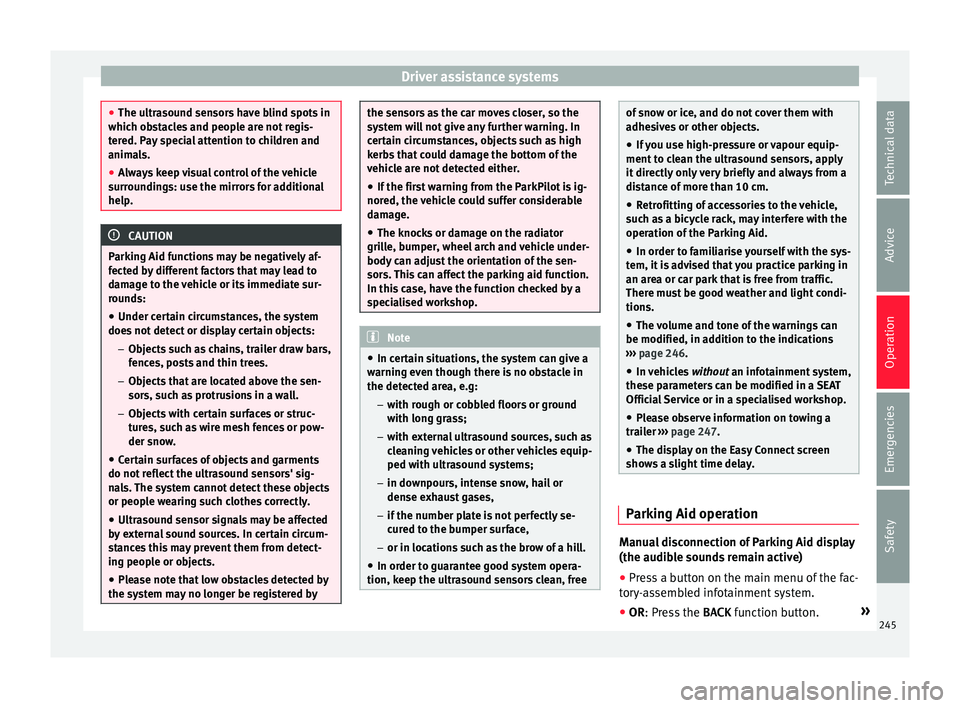
Driver assistance systems
●
The u ltr
asound sensors have blind spots in
which obstacles and people are not regis-
tered. Pay special attention to children and
animals.
● Always keep visual control of the vehicle
surr
oundings: use the mirrors for additional
help. CAUTION
Parking Aid functions may be negatively af-
f ect
ed by different factors that may lead to
damage to the vehicle or its immediate sur-
rounds:
● Under certain circumstances, the system
does
not detect or display certain objects:
– Objects such as chains, trailer draw bars,
fences, posts and thin trees.
– Objects that are located above the sen-
sors, such as protrusions in a wall.
– Objects with certain surfaces or struc-
tures, such as wire mesh fences or pow-
der snow.
● Certain surfaces of objects and garments
do not r
eflect the ultrasound sensors' sig-
nals. The system cannot detect these objects
or people wearing such clothes correctly.
● Ultrasound sensor signals may be affected
by
external sound sources. In certain circum-
stances this may prevent them from detect-
ing people or objects.
● Please note that low obstacles detected by
the sys
tem may no longer be registered by the sensors as the car moves closer, so the
sy
s
tem will not give any further warning. In
certain circumstances, objects such as high
kerbs that could damage the bottom of the
vehicle are not detected either.
● If the first warning from the ParkPilot is ig-
nored, the
vehicle could suffer considerable
damage.
● The knocks or damage on the radiator
gril
le, bumper, wheel arch and vehicle under-
body can adjust the orientation of the sen-
sors. This can affect the parking aid function.
In this case, have the function checked by a
specialised workshop. Note
● In c er
tain situations, the system can give a
warning even though there is no obstacle in
the detected area, e.g:
–with rough or cobbled floors or ground
with long grass;
– with external ultrasound sources, such as
cleaning vehicles or other vehicles equip-
ped with ultrasound systems;
– in downpours, intense snow, hail or
dense exhaust gases,
– if the number plate is not perfectly se-
cured to the bumper surface,
– or in locations such as the brow of a hill.
● In order to guarantee good system opera-
tion, keep the u
ltrasound sensors clean, free of snow or ice, and do not cover them with
a
dhe
sives or other objects.
● If you use high-pressure or vapour equip-
ment t
o clean the ultrasound sensors, apply
it directly only very briefly and always from a
distance of more than 10 cm.
● Retrofitting of accessories to the vehicle,
suc
h as a bicycle rack, may interfere with the
operation of the Parking Aid.
● In order to familiarise yourself with the sys-
tem, it
is advised that you practice parking in
an area or car park that is free from traffic.
There must be good weather and light condi-
tions.
● The volume and tone of the warnings can
be modified, in ad
dition to the indications
››› page 246.
● In vehicles without
an infotainment system,
these parameters can be modified in a SEAT
Official Service or in a specialised workshop.
● Please observe information on towing a
trai
ler ››› page 247.
● The display on the Easy Connect screen
show
s a slight time delay. Parking Aid operation
Manual disconnection of Parking Aid display
(the audib
l
e sounds remain active)
● Press a button on the main menu of the fac-
t or
y-assembled infotainment system.
● OR: Pr ess the BACK f
unction button. »
245
Technical data
Advice
Operation
Emergencies
Safety
Page 276 of 328
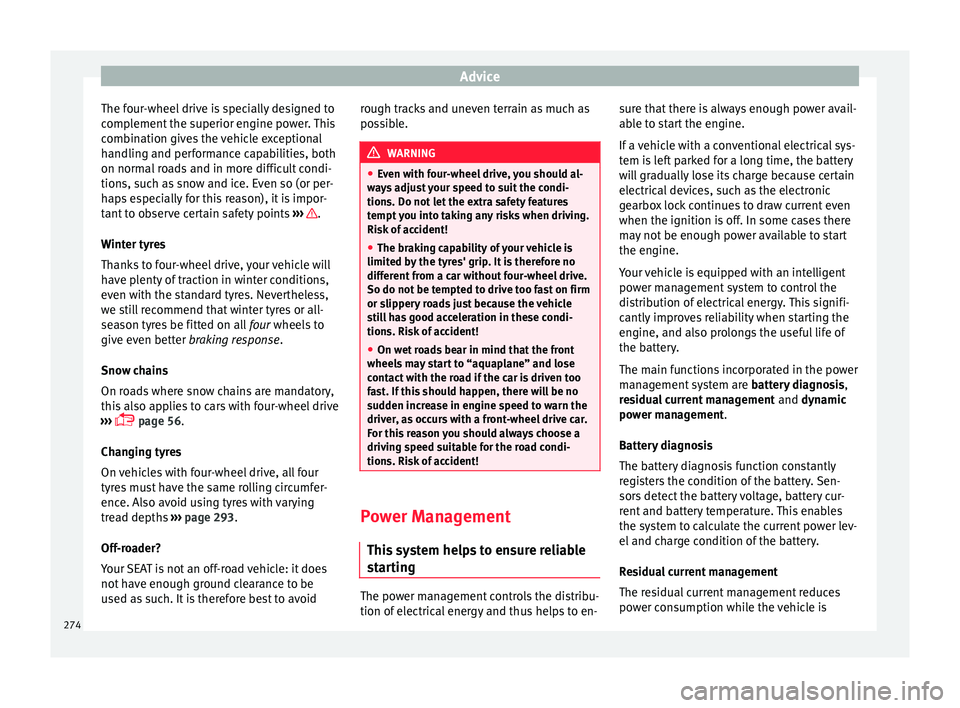
Advice
The four-wheel drive is specially designed to
c omp
lement the superior engine power. This
combination gives the vehicle exceptional
handling and performance capabilities, both
on normal roads and in more difficult condi-
tions, such as snow and ice. Even so (or per-
haps especially for this reason), it is impor-
tant to observe certain safety points ››› .
W int
er tyres
Thanks to four-wheel drive, your vehicle will
have plenty of traction in winter conditions,
even with the standard tyres. Nevertheless,
we still recommend that winter tyres or all-
season tyres be fitted on all four wheels to
give even better braking response.
Snow chains
On roads where snow chains are mandatory,
this also applies to cars with four-wheel drive
››› page 56.
Changing tyres
On vehicles with four-wheel drive, all four
tyres must have the same rolling circumfer-
ence. Also avoid using tyres with varying
tread depths ››› page 293.
Off-roader?
Your SEAT is not an off-road vehicle: it does
not have enough ground clearance to be
used as such. It is therefore best to avoid rough tracks and uneven terrain as much as
pos
sible. WARNING
● Ev
en with four-wheel drive, you should al-
ways adjust your speed to suit the condi-
tions. Do not let the extra safety features
tempt you into taking any risks when driving.
Risk of accident!
● The braking capability of your vehicle is
limited b
y the tyres' grip. It is therefore no
different from a car without four-wheel drive.
So do not be tempted to drive too fast on firm
or slippery roads just because the vehicle
still has good acceleration in these condi-
tions. Risk of accident!
● On wet roads bear in mind that the front
wheels
may start to “aquaplane” and lose
contact with the road if the car is driven too
fast. If this should happen, there will be no
sudden increase in engine speed to warn the
driver, as occurs with a front-wheel drive car.
For this reason you should always choose a
driving speed suitable for the road condi-
tions. Risk of accident! Power Management
Thi s
system helps to ensure reliable
starting The power management controls the distribu-
tion of
el
ectrical energy and thus helps to en- sure that there is always enough power avail-
abl
e to start the engine.
If a vehicle with a conventional electrical sys-
tem is left parked for a long time, the battery
will gradually lose its charge because certain
electrical devices, such as the electronic
gearbox lock continues to draw current even
when the ignition is off. In some cases there
may not be enough power available to start
the engine.
Your vehicle is equipped with an intelligent
power management system to control the
distribution of electrical energy. This signifi-
cantly improves reliability when starting the
engine, and also prolongs the useful life of
the battery.
The main functions incorporated in the power
management system are battery diagnosis,
residual current management and dynamic
power management.
Battery diagnosis
The battery diagnosis function constantly
registers the condition of the battery. Sen-
sors detect the battery voltage, battery cur-
rent and battery temperature. This enables
the system to calculate the current power lev-
el and charge condition of the battery.
Residual current management
The residual current management reduces
power consumption while the vehicle is
274
Page 299 of 328
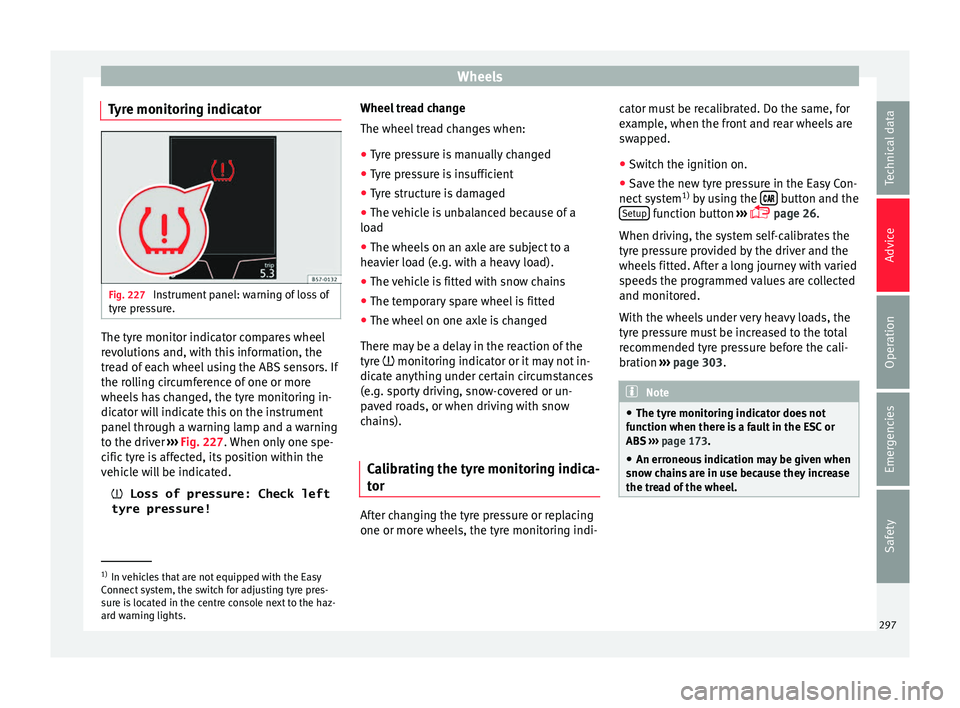
Wheels
Tyre monitoring indicator Fig. 227
Instrument panel: warning of loss of
ty r
e pressure. The tyre monitor indicator compares wheel
r
ev
olutions and, with this information, the
tread of each wheel using the ABS sensors. If
the rolling circumference of one or more
wheels has changed, the tyre monitoring in-
dicator will indicate this on the instrument
panel through a warning lamp and a warning
to the driver ››› Fig. 227. When only one spe-
cific tyre is affected, its position within the
vehicle will be indicated.
Loss of pressure: Check left
tyre pressure! Wheel tread change
The wheel tr
ead changes when:
● Tyre pressure is manually changed
● Tyre pressure is insufficient
● Tyre structure is damaged
● The vehicle is unbalanced because of a
loa
d
● The wheels on an axle are subject to a
heav
ier load (e.g. with a heavy load).
● The vehicle is fitted with snow chains
● The temporary spare wheel is fitted
● The wheel on one axle is changed
There m
ay be a delay in the reaction of the
tyre monitoring indicator or it may not in-
dicate anything under certain circumstances
(e.g. sporty driving, snow-covered or un-
paved roads, or when driving with snow
chains).
Calibrating the tyre monitoring indica-
tor After changing the tyre pressure or replacing
one or mor
e wheel
s, the tyre monitoring indi- cator must be recalibrated. Do the same, for
ex
ample, when the front and rear wheels are
swapped.
● Switch the ignition on.
● Save the new tyre pressure in the Easy Con-
nect sy
stem1)
by using the button and the
Set up function button
››
›
page 26.
When driving, the system self-calibrates the
tyre pressure provided by the driver and the
wheels fitted. After a long journey with varied
speeds the programmed values are collected
and monitored.
With the wheels under very heavy loads, the
tyre pressure must be increased to the total
recommended tyre pressure before the cali-
bration ››› page 303. Note
● The ty r
e monitoring indicator does not
function when there is a fault in the ESC or
ABS ››› page 173.
● An erroneous indication may be given when
sno
w chains are in use because they increase
the tread of the wheel. 1)
In vehicles that are not equipped with the Easy
C onnect
system, the switch for adjusting tyre pres-
sure is located in the centre console next to the haz-
ard warning lights. 297
Technical data
Advice
Operation
Emergencies
Safety
Page 300 of 328
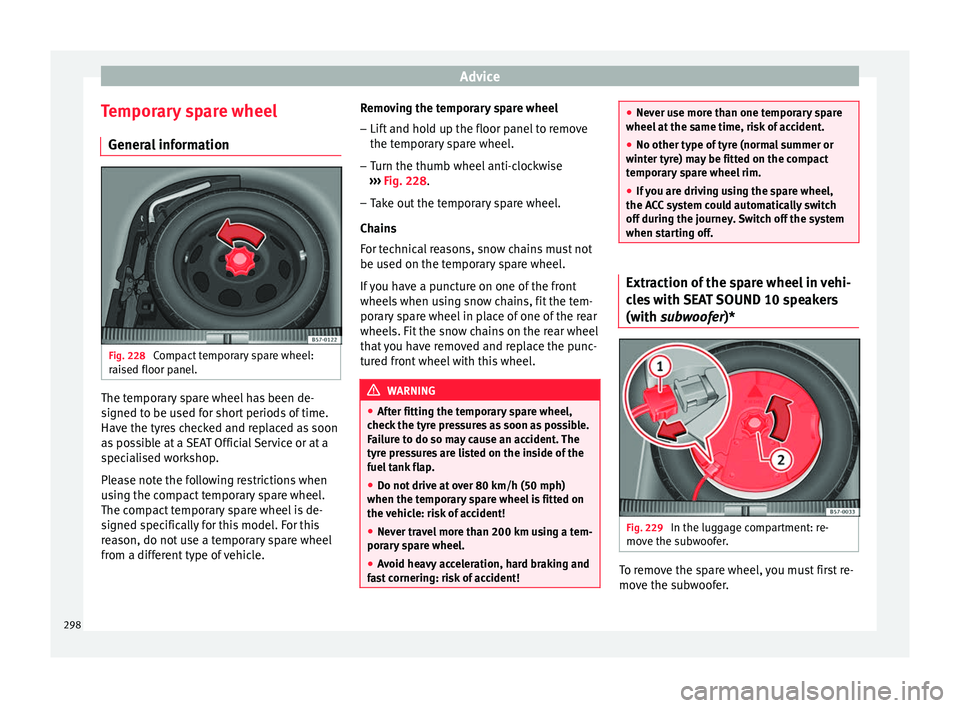
Advice
Temporary spare wheel Gener a
l information Fig. 228
Compact temporary spare wheel:
r ai
sed floor panel. The temporary spare wheel has been de-
s
igned t
o be used for short periods of time.
Have the tyres checked and replaced as soon
as possible at a SEAT Official Service or at a
specialised workshop.
Please note the following restrictions when
using the compact temporary spare wheel.
The compact temporary spare wheel is de-
signed specifically for this model. For this
reason, do not use a temporary spare wheel
from a different type of vehicle. Removing the temporary spare wheel
– Lift and hold up the floor panel to remove
the tempor
ary spare wheel.
– Turn the thumb wheel anti-clockwise
››
› Fig. 228.
– Take out the temporary spare wheel.
Chain
s
For technical reasons, snow chains must not
be used on the temporary spare wheel.
If you have a puncture on one of the front
wheels when using snow chains, fit the tem-
porary spare wheel in place of one of the rear
wheels. Fit the snow chains on the rear wheel
that you have removed and replace the punc-
tured front wheel with this wheel. WARNING
● Af t
er fitting the temporary spare wheel,
check the tyre pressures as soon as possible.
Failure to do so may cause an accident. The
tyre pressures are listed on the inside of the
fuel tank flap.
● Do not drive at over 80 km/h (50 mph)
when the tempor
ary spare wheel is fitted on
the vehicle: risk of accident!
● Never travel more than 200 km using a tem-
porar
y spare wheel.
● Avoid heavy acceleration, hard braking and
fa
st cornering: risk of accident! ●
Nev er u
se more than one temporary spare
wheel at the same time, risk of accident.
● No other type of tyre (normal summer or
wint
er tyre) may be fitted on the compact
temporary spare wheel rim.
● If you are driving using the spare wheel,
the AC
C system could automatically switch
off during the journey. Switch off the system
when starting off. Extraction of the spare wheel in vehi-
c
l
es with SEAT SOUND 10 speakers
(with subwoofer)* Fig. 229
In the luggage compartment: re-
mo v
e the subwoofer. To remove the spare wheel, you must first re-
mo
v
e the subwoofer.
298
Page 305 of 328
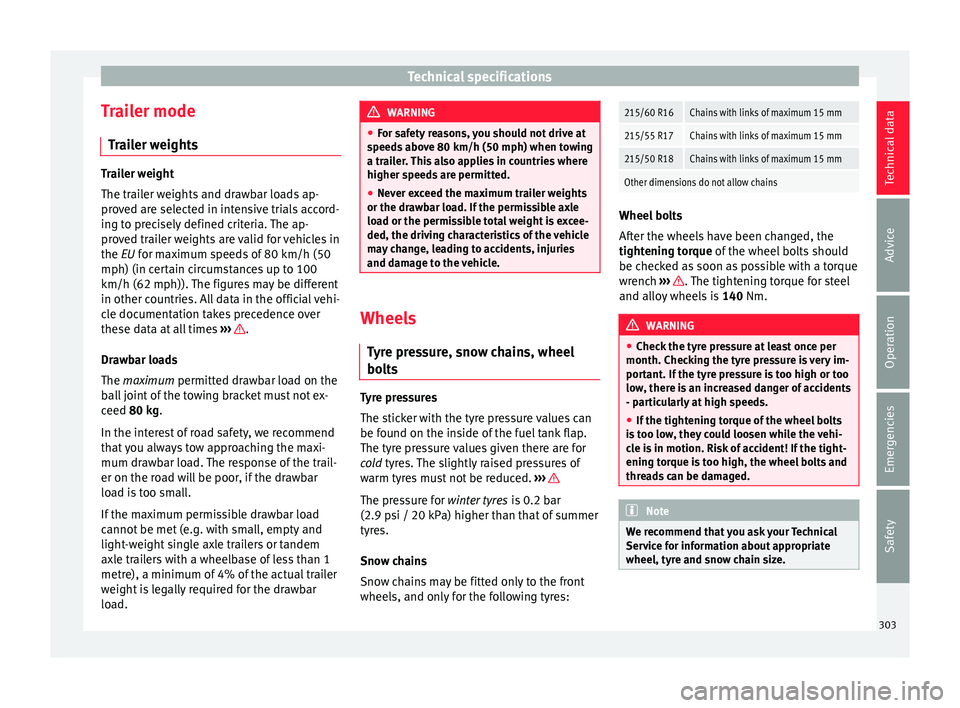
Technical specifications
Trailer mode Tr
ailer weights Trailer weight
The tr
ai
ler weights and drawbar loads ap-
proved are selected in intensive trials accord-
ing to precisely defined criteria. The ap-
proved trailer weights are valid for vehicles in
the EU for maximum speeds of 80 km/h (50
mph) (in certain circumstances up to 100
km/h (62 mph)). The figures may be different
in other countries. All data in the official vehi-
cle documentation takes precedence over
these data at all times ››› .
Dr a
wbar loads
The maximum permitted drawbar load on the
ball joint of the towing bracket must not ex-
ceed 80 kg.
In the interest of road safety, we recommend
that you always tow approaching the maxi-
mum drawbar load. The response of the trail-
er on the road will be poor, if the drawbar
load is too small.
If the maximum permissible drawbar load
cannot be met (e.g. with small, empty and
light-weight single axle trailers or tandem
axle trailers with a wheelbase of less than 1
metre), a minimum of 4% of the actual trailer
weight is legally required for the drawbar
load. WARNING
● For s
afety reasons, you should not drive at
speeds above 80 km/h (50 mph) when towing
a trailer. This also applies in countries where
higher speeds are permitted.
● Never exceed the maximum trailer weights
or the dra
wbar load. If the permissible axle
load or the permissible total weight is excee-
ded, the driving characteristics of the vehicle
may change, leading to accidents, injuries
and damage to the vehicle. Wheels
Ty
re pressure, snow chains, wheel
bolts Tyre pressures
The s
tic
ker with the tyre pressure values can
be found on the inside of the fuel tank flap.
The tyre pressure values given there are for
cold tyres. The slightly raised pressures of
warm tyres must not be reduced. ››› The pressure for win
t
er tyres is 0.2 bar
(2.9 psi / 20 kPa) higher than that of summer
tyres.
Snow chains
Snow chains may be fitted only to the front
wheels, and only for the following tyres:
215/60 R16Chains with links of maximum 15 mm
215/55 R17Chains with links of maximum 15 mm
215/50 R18Chains with links of maximum 15 mm
Other dimensions do not allow chains Wheel bolts
Af
t
er the wheels have been changed, the
tightening torque of the wheel bolts should
be checked as soon as possible with a torque
wrench ››› . The tightening torque for steel
and al lo
y wheels is 140 Nm. WARNING
● Chec k
the tyre pressure at least once per
month. Checking the tyre pressure is very im-
portant. If the tyre pressure is too high or too
low, there is an increased danger of accidents
- particularly at high speeds.
● If the tightening torque of the wheel bolts
is
too low, they could loosen while the vehi-
cle is in motion. Risk of accident! If the tight-
ening torque is too high, the wheel bolts and
threads can be damaged. Note
We recommend that you ask your Technical
Ser v
ice for information about appropriate
wheel, tyre and snow chain size. 303
Technical data
Advice
Operation
Emergencies
Safety
Page 315 of 328
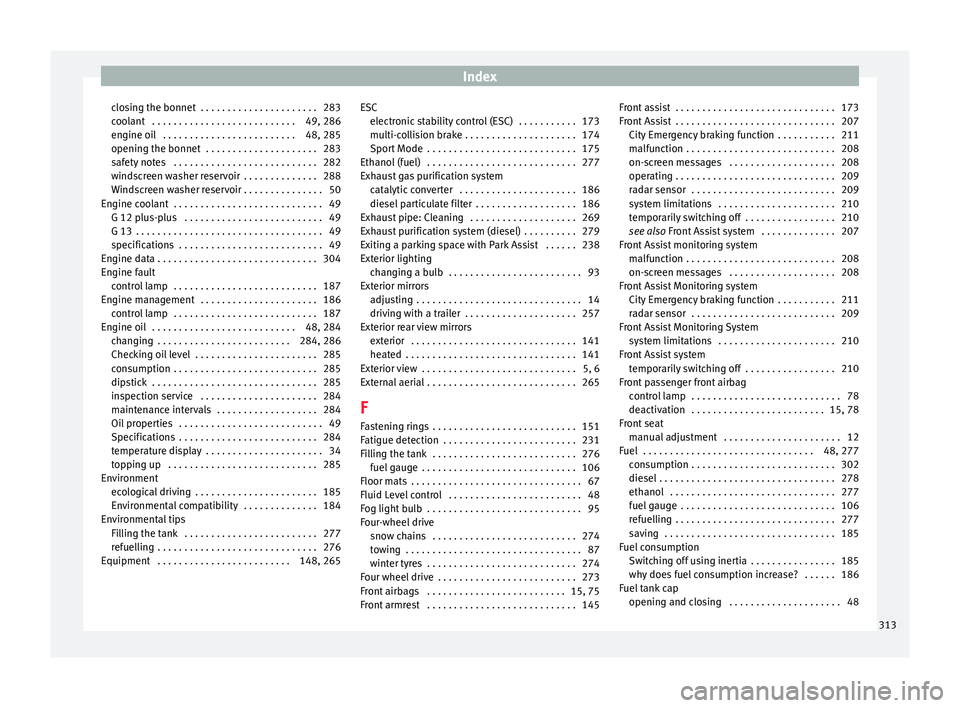
Index
closing the bonnet . . . . . . . . . . . . . . . . . . . . . . 283
c oo
lant . . . . . . . . . . . . . . . . . . . . . . . . . . . 49, 286
engine oil . . . . . . . . . . . . . . . . . . . . . . . . . 48, 285
opening the bonnet . . . . . . . . . . . . . . . . . . . . . 283
safety notes . . . . . . . . . . . . . . . . . . . . . . . . . . . 282
windscreen washer reservoir . . . . . . . . . . . . . . 288
Windscreen washer reservoir . . . . . . . . . . . . . . . 50
Engine coolant . . . . . . . . . . . . . . . . . . . . . . . . . . . . 49 G 12 plus-plus . . . . . . . . . . . . . . . . . . . . . . . . . . 49
G 13 . . . . . . . . . . . . . . . . . . . . . . . . . . . . . . . . . . . 49
specifications . . . . . . . . . . . . . . . . . . . . . . . . . . . 49
Engine data . . . . . . . . . . . . . . . . . . . . . . . . . . . . . . 304
Engine fault control lamp . . . . . . . . . . . . . . . . . . . . . . . . . . . 187
Engine management . . . . . . . . . . . . . . . . . . . . . . 186 control lamp . . . . . . . . . . . . . . . . . . . . . . . . . . . 187
Engine oil . . . . . . . . . . . . . . . . . . . . . . . . . . . 48, 284 changing . . . . . . . . . . . . . . . . . . . . . . . . . 284, 286
Checking oil level . . . . . . . . . . . . . . . . . . . . . . . 285
consumption . . . . . . . . . . . . . . . . . . . . . . . . . . . 285
dipstick . . . . . . . . . . . . . . . . . . . . . . . . . . . . . . . 285
inspection service . . . . . . . . . . . . . . . . . . . . . . 284
maintenance intervals . . . . . . . . . . . . . . . . . . . 284
Oil properties . . . . . . . . . . . . . . . . . . . . . . . . . . . 49
Specifications . . . . . . . . . . . . . . . . . . . . . . . . . . 284
temperature display . . . . . . . . . . . . . . . . . . . . . . 34
topping up . . . . . . . . . . . . . . . . . . . . . . . . . . . . 285
Environment ecological driving . . . . . . . . . . . . . . . . . . . . . . . 185
Environmental compatibility . . . . . . . . . . . . . . 184
Environmental tips Filling the tank . . . . . . . . . . . . . . . . . . . . . . . . . 277
refuelling . . . . . . . . . . . . . . . . . . . . . . . . . . . . . . 276
Equipment . . . . . . . . . . . . . . . . . . . . . . . . . 148, 265 ESC
electr onic stability control (ESC) . . . . . . . . . . . 173
multi-collision brake . . . . . . . . . . . . . . . . . . . . . 174
Sport Mode . . . . . . . . . . . . . . . . . . . . . . . . . . . . 175
Ethanol (fuel) . . . . . . . . . . . . . . . . . . . . . . . . . . . . 277
Exhaust gas purification system catalytic converter . . . . . . . . . . . . . . . . . . . . . . 186
diesel particulate filter . . . . . . . . . . . . . . . . . . . 186
Exhaust pipe: Cleaning . . . . . . . . . . . . . . . . . . . . 269
Exhaust purification system (diesel) . . . . . . . . . . 279
Exiting a parking space with Park Assist . . . . . . 238
Exterior lighting changing a bulb . . . . . . . . . . . . . . . . . . . . . . . . . 93
Exterior mirrors adjusting . . . . . . . . . . . . . . . . . . . . . . . . . . . . . . . 14
driving with a trailer . . . . . . . . . . . . . . . . . . . . . 257
Exterior rear view mirrors exterior . . . . . . . . . . . . . . . . . . . . . . . . . . . . . . . 141
heated . . . . . . . . . . . . . . . . . . . . . . . . . . . . . . . . 141
Exterior view . . . . . . . . . . . . . . . . . . . . . . . . . . . . . 5, 6
External aerial . . . . . . . . . . . . . . . . . . . . . . . . . . . . 265
F Fastening rings . . . . . . . . . . . . . . . . . . . . . . . . . . . 151
Fatigue detection . . . . . . . . . . . . . . . . . . . . . . . . . 231
Filling the tank . . . . . . . . . . . . . . . . . . . . . . . . . . . 276 fuel gauge . . . . . . . . . . . . . . . . . . . . . . . . . . . . . 106
Floor mats . . . . . . . . . . . . . . . . . . . . . . . . . . . . . . . . 67
Fluid Level control . . . . . . . . . . . . . . . . . . . . . . . . . 48
Fog light bulb . . . . . . . . . . . . . . . . . . . . . . . . . . . . . 95
Four-wheel drive snow chains . . . . . . . . . . . . . . . . . . . . . . . . . . . 274
towing . . . . . . . . . . . . . . . . . . . . . . . . . . . . . . . . . 87
winter tyres . . . . . . . . . . . . . . . . . . . . . . . . . . . . 274
Four wheel drive . . . . . . . . . . . . . . . . . . . . . . . . . . 273
Front airbags . . . . . . . . . . . . . . . . . . . . . . . . . . 15, 75
Front armrest . . . . . . . . . . . . . . . . . . . . . . . . . . . . 145 Front assist . . . . . . . . . . . . . . . . . . . . . . . . . . . . . . 173
Front
Assist . . . . . . . . . . . . . . . . . . . . . . . . . . . . . . 207
City Emergency braking function . . . . . . . . . . . 211
malfunction . . . . . . . . . . . . . . . . . . . . . . . . . . . . 208
on-screen messages . . . . . . . . . . . . . . . . . . . . 208
operating . . . . . . . . . . . . . . . . . . . . . . . . . . . . . . 209
radar sensor . . . . . . . . . . . . . . . . . . . . . . . . . . . 209
system limitations . . . . . . . . . . . . . . . . . . . . . . 210
temporarily switching off . . . . . . . . . . . . . . . . . 210
see also Front Assist system . . . . . . . . . . . . . . 207
Front Assist monitoring system malfunction . . . . . . . . . . . . . . . . . . . . . . . . . . . . 208
on-screen messages . . . . . . . . . . . . . . . . . . . . 208
Front Assist Monitoring system City Emergency braking function . . . . . . . . . . . 211
radar sensor . . . . . . . . . . . . . . . . . . . . . . . . . . . 209
Front Assist Monitoring System system limitations . . . . . . . . . . . . . . . . . . . . . . 210
Front Assist system temporarily switching off . . . . . . . . . . . . . . . . . 210
Front passenger front airbag control lamp . . . . . . . . . . . . . . . . . . . . . . . . . . . . 78
deactivation . . . . . . . . . . . . . . . . . . . . . . . . . 15, 78
Front seat manual adjustment . . . . . . . . . . . . . . . . . . . . . . 12
Fuel . . . . . . . . . . . . . . . . . . . . . . . . . . . . . . . . 48, 277 consumption . . . . . . . . . . . . . . . . . . . . . . . . . . . 302
diesel . . . . . . . . . . . . . . . . . . . . . . . . . . . . . . . . . 278
ethanol . . . . . . . . . . . . . . . . . . . . . . . . . . . . . . . 277
fuel gauge . . . . . . . . . . . . . . . . . . . . . . . . . . . . . 106
refuelling . . . . . . . . . . . . . . . . . . . . . . . . . . . . . . 277
saving . . . . . . . . . . . . . . . . . . . . . . . . . . . . . . . . 185
Fuel consumption Switching off using inertia . . . . . . . . . . . . . . . . 185
why does fuel consumption increase? . . . . . . 186
Fuel tank cap opening and closing . . . . . . . . . . . . . . . . . . . . . 48
313